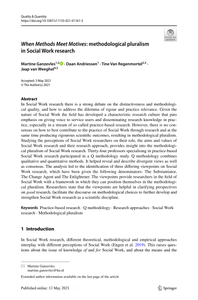Currently, there is no common understanding of categorizing, conceptualizing, and measuring consumption motives in the performing arts. Study one presents the results of forty-seven semi-structured, in-depth interviews and deepens the understanding of consumption motives. A new framework consisting of cultural and social motives is introduced. This framework is tested in the second study. Here, a quantitative instrument is developed. The results of the principal components analysis refine the framework and demonstrate the following consumption motives: cultural aesthetics (with two dimensions: artistic value and enjoyment of beauty), cultural relaxation, cultural stimulation, social bonding, social attraction, social distinction, and social duty.
LINK
The aim of this study was to understand the motives for using the Internet, and its associations with users' attitudes, social values, and relational involvement. Also, this study attempted to crossculturally compare the difference in the pattern of motives and the associations among three countries ' the US, the Netherlands, and S. Korea. The design of methods was based on examination and revision of uses and gratification approach toward Internet users. Findings from factor analysis revealed that information seeking and Self-Improvement were the dominant and common reasons for using the Internet across three countries. The differences in the composition of motives in each country were also reported. Strong correlations across countries were found between all the motives and satisfaction of the Internet. Expectation and positive evaluation of the Internet were also important attitudes associated with Internet use motives. Postmaterialist value showed strong association with motives of information seeking and Self-Improvement. Community involvement was significantly associated with Internet use motives in Korean users.
DOCUMENT
"In recent years, the former Dutch welfare state has been transformed into a participation society [1]. As support from the government decreases, citizens are increasingly expected to be self-managing. Since not everyone is able to be self-managing, there is an increasing demand for help offered by volunteers. Although the number of volunteers in the Netherlands is relatively stable, the amount of time per volunteer has decreased over the past couple of years [2]. Most volunteers traditionally come from the wealthier, more educated segment of society and are likely to be female, married with children, 50+, and active in religion [3, 4]. In order to meet the increasing demand for volunteers, either the amount of time spent per volunteer should be increased, or new groups of volunteers should be attracted. The Dutch foundation “Possible Today” started an initiative aimed at motivating (potential) volunteers: Social Credits for Volunteers. This is digital platform, based on block chain technology, connects volunteers with projects. The platform uses a digital currency -Social Credits- to appreciate and reward the efforts of volunteers. The currency can be exchanged for discounts or other value, offered by organizations and stores that feel involved with the community. An important feature of this system is the opportunity for volunteers to draft a social curriculum vitae. The aim of this study is to generate recommendations for Possible Foundation about how the Social Credits Platform should be designed and deployed in order to persuade (potential) volunteers to spend (more) hours on volunteering. Therefore, the following research question is answered: ‘What motives, desires and barriers traditional and less traditional volunteers have in regard to appreciation and reward for volunteering?’"
DOCUMENT

In Social Work research there is a strong debate on the distinctiveness and methodological quality, and how to address the dilemma of rigour and practice relevance. Given the nature of Social Work the field has developed a characteristic research culture that puts emphasis on giving voice to service users and disseminating research knowledge in practice, especially in a stream of so called practice-based research. However, there is no consensus on how to best contribute to the practice of Social Work through research and at the same time producing rigourous scientific outcomes, resulting in methodological pluralism. Studying the perceptions of Social Work researchers on their role, the aims and values of Social Work research and their research approach, provides insight into the methodological pluralism of Social Work research. Thirty-four professors specialising in practice-based Social Work research participated in a Q methodology study. Q methodology combines qualitative and quantitative methods. It helped reveal and describe divergent views as well as consensus. The analysis led to the identification of three differing viewpoints on Social Work research, which have been given the following denominators: The Substantiator, The Change Agent and The Enlightener. The viewpoints provide researchers in the field of Social Work with a framework in which they can position themselves in the methodological pluralism. Researchers state that the viewpoints are helpful in clarifying perspectives on good research, facilitate the discourse on methodological choices to further develop and strengthen Social Work research as a scientific discipline
DOCUMENT

Presentation at the European Conference for Social Work Research, Leuven: Belgium
DOCUMENT

Chapter 8 in Comsumption Culture in Europe. This chapter presents an analysis of what consumer in Europe drink and why they drink what they drink. The concept of drinking motives is developed and defined, and analysis of data on drinking motives shows that these can be grouped into two major classes: self-expressive and functional. This distinction is universal and hence applies across Europe. However, the importance of self-expressive as compared to functional motives, as well as the way in which these relate to different beverages, does differ across Europe. Both dimensions are relevant for the motives for drinking non-alcoholic drinks, whereas the self-expression dimension dominates reasons for drinking alcoholic drinks. The Eastern European countries have generally higher scores on the self-expression dimension, indicating that such motives play a bigger role there compared to the other regions. No clear geographical pattern emerged with regard to the functional dimension. Beer and spirits are the alcoholic drinks and tea, water, and juice the non-alcoholic drinks that are related to high scores on the self-expression dimension. Water and juice are the drinks scoring highest on functionality, being mainly related to health, availability, and quenching one’s thirst. The non-alcoholic products scoring low on functionality are coffee, tea, soft drinks, and energy drinks. Analysis of socio-demographic differences resulted in only a few effects. Men, lower education groups, and lower income groups are more likely to drink alcohol for reasons other than self-expression motives (such as to quench one’s thirst). Also, the health motive plays a larger role for older people, and the self-expressive and social motives play a larger role for younger people. The chapter closes with recommendations for the marketing of drink products in Europe.
LINK
Background: Running has become one of the most popular sports and has proven benefits for public health. Policy makers are increasingly aware that attractively designed public spaces may promote running. However, little is known about what makes a running environment attractive and restorative for runners and to what extent this depends on characteristics of the runner. This study aims to investigate 1) to what extent intrapersonal characteristics (i.e. motives and attitudes) and perceived environmental characteristics (e.g. quality of the running surface, greenness of the route, feelings of safety and hinderance by other road users) are associated with the perceived attractiveness and restorative capacity of the running environment and 2) to what extent the number of years of running experience modify these associations. Methods: Cross-sectional data were collected through the online Eindhoven Running Survey 2015 (ERS15) among half marathon runners (N = 2477; response rate 26.6%). Linear regression analyses were performed for two outcomes separately (i.e. perceived attractiveness and perceived restorative capacity of the running environment) to investigate their relations with motives and attitudes, perceived environmental characteristics and interactions between perceived environmental characteristics and number of years of running experience. Results: Perceived environmental characteristics, including green and lively routes and a comfortable running surface were more important for runners’ evaluation of the attractiveness and restorative capacity of the running environment than runners’ motives and attitudes. In contrast to experienced runners, perceived hinder from unleashed dogs and pedestrians positively impacted the attractiveness and restorative capacity for less experienced runners. Conclusions: Perceived environmental characteristics were important determinants of the attractiveness and restorative capacity of the running environment for both novice and experienced runners. However, green and lively elements in the running environment and hinderances by cars were more important for less experienced runners. In order to keep novice runners involved in running it is recommended to design comfortable running tracks and routes and provide good access to attractive, green and lively spaces.
DOCUMENT

This research aims to contribute to a better understanding of strategic collaborations between work-integration social enterprises (WISEs) and for-profit enterprises (FPEs) with the joint objective to improve labour market opportunities for vulnerable groups. We find that most collaborations strive towards integration or transformation in order to make more social impact.
LINK
The purpose of the research we undertook for this Conference Paper was to investigate whether marketing campaigns for specific types of drinks could be directed towards age cohorts rather than towards intercultural differences between countries. We developed consumer profiles based on drinking motives and drinking behavior by age cohorts. We hypothesized that differences between countries in the youngest age groups are smaller than in the older age groups, where country specific tradition and culture still plays a more prominent role. We, therefore tested, from the data obtained by the COnsumer BEhaviouR Erasmus Network (COBEREN), the hypothesis that the extent to which the age specific profiles differ between countries increases with age. The results confirm our hypothesis that the extent to which drinking motives differ between countries increases with age. Our results suggest that marketing campaigns which are directed towards drinking motives, could best be tailored by age cohort, in particular when it concerns age group 18-37 and more particular for beer, spirits and especially premix drinks. Marketing campaigns for non-alcoholic beverages should be made specific for the British countries and the Western countries, but even more effectively be made specific for the age cohort 18-37.
DOCUMENT

Wereldwijd onderzoek: Hoe gebruiken nieuwsmedia social media? Jongeren lezen geen krant meer, ze kijken op hun smartphone die ze altijd bij de hand hebben. Binnen het lectoraat social media en reputatiemanagement van NHL hogeschool te Leeuwarden heeft een groep internationale studenten in 12 landen onderzoek gedaan. Hierbij hebben ze meer dan 150 social media sites bestudeerd van nieuws media. De resultaten maken deel uit van een internationaal onderzoek van NHL Hogeschool en Haaga Helia University. De onderzoeksvraag was: Wat speelt zich af in de nieuwsmedia? Persbureaus kunnen het overzicht gebruiken om hun social media te optimaliseren. En voor ieder die journalistiek een warm hart toedraagt is het interessante informatie over de nieuwsmedia in een overgangssituatie (2nd edition)
DOCUMENT
